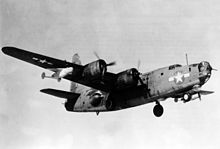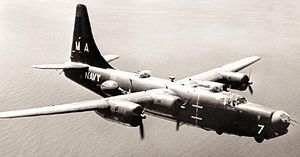- Consolidated PB4Y-2 Privateer
-
"P4Y" redirects here. For the earlier aircraft designated P4Y, see Consolidated XP4Y Corregidor.
PB4Y-2/P4Y-2 Privateer U.S. Navy PB4Y-2 from VP-23 in flight. Role Maritime patrol bomber Manufacturer Consolidated Aircraft Introduction 1943 Retired 1954, U.S. Navy
1958, U.S. Coast GuardPrimary users United States Navy
United States Coast GuardProduced 1943–1945 Number built 739 Developed from Consolidated B-24 Liberator The Consolidated PB4Y-2 Privateer was a World War II and Korean War era patrol bomber of the United States Navy derived from the Consolidated B-24 Liberator. The Navy had been using unmodified B-24s as the PB4Y-1 Liberator, and the type was considered very successful. A fully navalized design was desired, and Consolidated developed a dedicated long-range patrol bomber in 1943, designated PB4Y-2 Privateer.[1] In 1951, the series was redesignated P4Y-2 Privateer. A further change occurred in October 1962 when remaining Navy Privateers (all having previously been converted to drone configuration as P4Y-2K) were redesignated QP-4B.
Contents
Design and development
 A PB4Y-2 carrying ASM-N-2 Bat glide bombs.
A PB4Y-2 carrying ASM-N-2 Bat glide bombs.
The Privateer was externally similar to the Liberator, but the fuselage was longer to accommodate a flight engineer's station, and had a tall single vertical stabilizer rather than the B-24's twin tail configuration. The defensive armament was also increased to 12 .50-in (12.7 mm) M2 Browning machine guns in six turrets (two dorsal, two waist, nose and tail), with the B-24's belly turret being omitted. Turbosuperchargers were not fitted to the engines since maritime patrol missions were not usually flown at high altitude.
The Ford Motor Company (which produced B-24s for the United States Army Air Forces) had earlier built an experimental variant (B-24K) using the single tail of a B-23 Dragon.[2] Aircraft handling was improved, and the Air Corps' proposed B-24N production model was to be built by Ford, but the order was canceled on 31 May 1945 and the B-24N never entered production. The Navy's desire for substantial redesigns, however, had sustained interest in the new tail assembly.
The Navy eventually took delivery of 739 Privateers, the majority after the end of the war, although several squadrons saw service in the Pacific theater in the reconnaissance, search and rescue, electronic countermeasures, communication relay, and anti-shipping roles (the latter with the "Bat" guided bomb.)
Operational history
The Privateer entered Navy service during late 1944. Squadrons VPB-118 and VPB-119 were the first Fleet squadrons to equip with the Privateer. The first overseas deployment began on 6 January 1945, when VPB-118 left for operations in the Marianas. On 2 March 1945 VPB-119 began "offensive search" missions out of Clark Field, Luzon in the Philippines, flying sectored searches of the seas and coastlines extending from the Gulf of Tonkin in the south, along the Chinese coast, and beyond Okinawa in the north.
The Privateer was used as a typhoon/hurricane hunter from 1945 to the mid-1950s. One aircraft, designated BuNo 59415 of VPB-119 went down when it experienced mechanical trouble when investigating a Category 1 typhoon near Batan Island in the Philippines. It attempted to land on the island, but was unable to do so and crashed. It was one of the only six hurricane hunter flights ever lost, and the only one found.[3]
Privateers were also used during the Korean War to fly "Firefly" night illumination missions dropping parachute flares to detect North Korean and Chinese seaborne infiltrators. In addition, Privateers were used by the US Navy for signals intelligence flights off of the coast of the Soviet Union and the People's Republic of China. On 8 April 1950, Soviet La-11 fighters shot down US Navy PB4Y-2 Privateer (BuNo 59645) Turbulent Turtle of VP-26, Det A over the Baltic Sea, off the coast of Lepija, Latvia.[4]
All Navy PB4Y-2s were retired by 1954, though unarmed PB4Y-2G Privateers served until 1958 with the Coast Guard before being auctioned off for salvage.
The family was redesignated P4Y-2 Privateer in 1951. The earlier XP4Y-1 Corregidor was a completely different design, based on the Consolidated Model 31 twin-engine flying boat.
PB4Y-2 were still being used as drones in the 1950s/early 1960s, designated PB4Y-2K initially and then P4Y-2 based names after 1951.[citation needed][clarification needed] They were then redesignated QP-4B under the 1962 United States Tri-Service aircraft designation system, part of the new patrol series, between the Lockheed P-3 Orion and the Martin P-5 Marlin.
A number of PB4Ys were supplied to the Republic of China Air Force for use in missions over the People's Republic of China. One was shot down by ground fire on 12 September 1954, near Xiamen, People's Republic of China. The crew of nine were killed. Another was shot down on 15 February 1961 by Burmese Hawker Sea Fury fighter aircraft, near the Thai-Burmese border, killing the crew of five. Two other crew members were taken prisoner. This aircraft was carrying supplies for Chinese Kuomintang forces fighting in northern Burma.[5]
Privateers in aerial firefighting
 P4Y-2 Tanker 123 BuNo 66260 (N7620C), in service with the CDF, at Chester Air Attack Base in the late 1990s—crashed 18 July 2002.
P4Y-2 Tanker 123 BuNo 66260 (N7620C), in service with the CDF, at Chester Air Attack Base in the late 1990s—crashed 18 July 2002.
 PB4Y-2 BuNo 66261 (marked as BuNo 66304) in the collection of the National Museum of Naval Aviation at NAS Pensacola, Florida.
PB4Y-2 BuNo 66261 (marked as BuNo 66304) in the collection of the National Museum of Naval Aviation at NAS Pensacola, Florida.
A limited number of refitted PB4Ys continued in civilian service as airtankers, dropping fire retardant on forest fires throughout the western United States. On 18 July 2002, one such refitted PB4Y, BuNo 66260 (seen in picture to right) operated by Hawkins and Powers Aviation of Wyoming, broke up in flight while fighting a wildfire near Rocky Mountain National Park. Both crew members were killed in the accident, and the Federal Aviation Administration temporarily grounded all large air tankers in the region.[6] Following the accident, all remaining Privateers were retired. (See 2002 airtanker crashes.)
Variants
- PB4Y-2 :
- PB4Y-2B:
- PB4Y-2M:
- PB4Y-2S:
- PB4Y-2G:
- PB4Y-2K:
- P4Y-2 :
- P4Y-2B:
- P4Y-2M:
- P4Y-2S:
- P4Y-2G:
- P4Y-2K :
- QP-4B :
Operators
See also: List of PB4Y Privateer operatorsSurvivors
- PB4Y-2 (BuNo 59819) is under restoration at the Lone Star Flight Museum in Galveston, Texas.[7]
- PB4Y-2 (BuNo 59876) Tanker 125 is on display at the Yankee Air Force in Belleville, Michigan.[8]
- PB4Y-2 (BuNo 59882) Tanker 126 is airworthy but grounded at the Hawkins and Powers Aviation in Greybull, Wyoming.[9]
- PB4Y-2 (BuNo 66261) is on display at the National Museum of Naval Aviation in Naval Air Station Pensacola, Florida.[10]
- PB4Y-2 (BuNo 66300) Tanker 124 is airworthy but grounded at the Hawkins and Powers Aviation in Greybull, Wyoming.[11]
- PB4Y-2 (BuNo 66302) Tanker 121 is airworthy but was grounded at the Hawkins and Powers Aviation in Greybull, Wyoming. It left the Casa Grande Municipal Airport (KCGZ) in Casa Grande, Arizona on 11 February 2011 for San Diego, California.[12]
Specifications (PB4Y-2)
Data from Jane's Fighting Aircraft of World War II[13]
General characteristics
- Crew: 11: two pilots, navigator, bombardier, five gunners, two radio operators
- Length: 74 ft 7 in (22.73 m)
- Wingspan: 110 ft 0 in (33.53 m)
- Height: 30 ft 1 in (9.17 m)
- Wing area: 1,048 ft² (97.4 m²)
- Empty weight: 27,485 lb (12,467 kg)
- Max takeoff weight: 65,000 lb (29,500 kg)
- Powerplant: 4 × Pratt & Whitney R-1830-94 radial engines, 1,650 hp (1,230 kW) each
Performance
- Maximum speed: 300 mph (261 kn, 482 km/h)
- Cruise speed: 175 mph (121 kn, 224 km/h)
- Range: 2,820 mi (2,450 nmi, 4,540 km)
- Service ceiling: 21,000 ft (6,400 m)
- Wing loading: 62 lb/ft² (300 kg/m²)
Armament
- Guns: 12 × .50 in (12.7 mm) M2 Browning machine guns in six turrets
- Bombs: Up to 12,800 lb (5,800 kg) of bombs, mines, or torpedoes
See also
- Related development
- Aircraft of comparable role, configuration and era
- Related lists
References
- Notes
- ^ Baugher, Joe. "Convair PB4Y-2 Privateer." American Military Aircraft, 23 August 1999. Retrieved: 13 November 2010.
- ^ Baugher, Joe. "Consolidated B-24N Liberator." American Military Aircraft. Retrieved: 13 November 2010.
- ^ Tannehill, Ivan Ray. The Hurricane Hunters. New York: Dodd Mead, 1955. ISBN 0-396-03789-5.
- ^ "Intrusions, Overflights, Shootdowns and Defections During the Cold War and Thereafter." ncnetwork.net. Retrieved: 25 July 2011.
- ^ Pocock, Chris. The Black Bats: CIA Spy Flights Over China From Taiwan, 1951–1969. Atglen, Pennsylvania: Schiffer Military History, 2010. ISBN 978-0764335136.
- ^ "Two Die in Crash Fighting Colorado Wildfire." Firehouse.com. Retrieved: 13 November 2010.
- ^ "Privateer/59819" Warbirds Resource Group Retrieved: 24 August 2010.
- ^ "Privateer/59876" Warbirds Resource Group Retrieved: 24 August 2010.
- ^ "Privateer/59882" Warbirds Resource Group Retrieved: 24 August 2010.
- ^ "Privateer/66261" Warbirds Resource Group Retrieved: 24 August 2010.
- ^ "Privateer/66300" Warbirds Resource Group Retrieved: 24 August 2010.
- ^ "Privateer/66302" Warbirds Resource Group Retrieved: 24 August 2010.
- ^ Bridgeman 1946, pp. 217–218.
- Bibliography
- Bridgeman, Leonard. “The Consolidated Vultee Privateer.” Jane's Fighting Aircraft of World War II. London: Studio, 1946.'ISBN 1-85170-493-0.
External links
- Manual: (1945) Flight Manual PB4Y-2 Airplane
- Aeroweb specs
- Warbird Alley
- Globalsecurity.org
- Aeroweb's PB4Y Location List
- Aeroweb's PB4Y at Lone Star Flight Museum Lone Star Flight Museum
Aircraft produced by Consolidated Aircraft Manufacturer designation By role USN/USMC patrol aircraft designations 1923-1962 Patrol HallKeystonePN • P2N • P4N
LockheedPOSikorskyPS • P2S
LockheedPatrol Bomber XPBB • PB2B
LockheedSikorskyPBSVickers CanadaPatrol Torpedo Bomber HallUnited States tri-service patrol aircraft designations post-1962 Lists relating to aviation General Aircraft (manufacturers) · Aircraft engines (manufacturers) · Airlines (defunct) · Airports · Civil authorities · Museums · Registration prefixes · Rotorcraft (manufacturers) · TimelineMilitary Accidents/incidents Records Categories:- Consolidated aircraft
- Military aircraft of the Korean War
- United States Coast Guard aircraft
- United States patrol aircraft 1930–1939
- World War II patrol aircraft of the United States
- Four-engined aircraft
Wikimedia Foundation. 2010.



